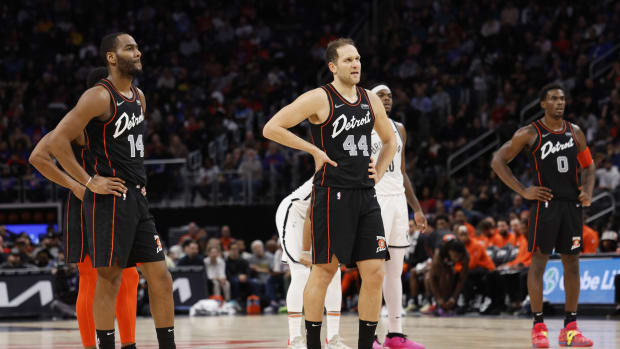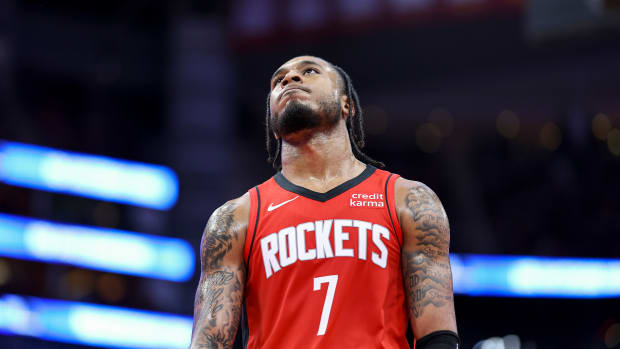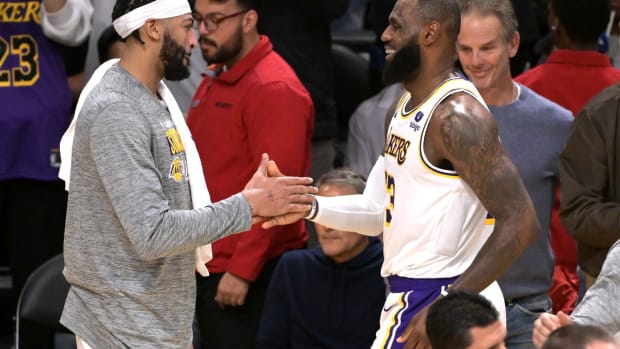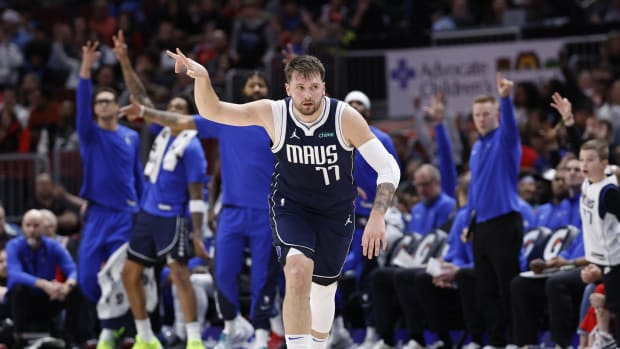The Jimmy Butler Trade Brings Mix of Tension and Opportunity to 76ers
Minnesota, having agreed to grant Jimmy Butler the trade he’s wanted for months, is finally free of its self-imposed purgatory. Philadelphia proved eager to help—so eager, in fact, as to give up two core players for Butler and all the baggage he brings with him. No one would soon confuse Dario Saric or Robert Covington for a star of Butler’s caliber. Both, however, were instrumental to the Sixers’ rise last season because of how smoothly they complemented Ben Simmons and Joel Embiid. Together with J.J. Redick, those four players formed the single most effective lineup in the NBA last season. To surrender them in a trade is no small thing.
With Butler comes both opportunity and tension. The very idea of aligning three players as talented as Embiid, Simmons and Butler is captivating; only the Warriors (and possibly the Celtics) could claim a top three of equal brilliance, positioning the Sixers for a promising sort of contention. History tells us that teams this loaded make noise. What kind is up to the stars involved, and how each navigates the inevitable stress between their skill sets. By broad characterization, Butler is exactly the kind of player Philly has been looking for: a high-level wing who is both versatile on offense and flexible on defense. In practice, Butler’s fit is more complicated.
GOLLIVER: After an Ugly End with Wolves, Butler Needs Philly to Win
The version of stardom Butler subscribes to comes by demanding the ball, pounding it into the floor and creating shots that few players can. Some logistical conflict is inevitable. Every possession Butler controls is one that Simmons isn’t orchestrating and Embiid isn’t running from the post. It’s another where the fact that Simmons can’t (and won’t) shoot is brought to the foreground. Talent tends to win out in these situations, but not without overcoming some initial awkwardness. Very few teams will have the individual defenders necessary to counter all three of Butler, Embiid and Simmons in a given matchup. Modern schemes, though, can shrink the space between stars to crowd the lane—an area vital for all three of the Sixers’ stars.
After spending his first few years with the Sixers coaxing offense from G-Leaguers, Brett Brown will likely welcome this sort of puzzle. Brown is the sort of coach who, when given a star point guard and a star center, finds inventive ways to work around the traditional—but predictable—pick-and-roll. Adding Butler is an extension of that philosophy: Give capable players structure, offer them creative outlets and trust them to figure it out. It’s not a foolproof formula, though it’s the kind that could find organic solutions to Philadelphia’s newfound overlap. Maybe adding Butler, the greatest scoring threat off the dribble that these Sixers have had, finally actualizes Simmons as a cutter and screener. Butler might turn Philly’s dribble hand-offs into more of a downhill exercise.
None of this can manifest, however, without some sacrifice on the part of Simmons and Embiid. Butler could do what Covington did, but won’t. This trade was designed to expand the Sixers’ horizons. Parting ways with Covington and Saric only makes sense if Philadelphia intends to try new things. Embiid, who has only known life as one of the highest usage players in the league, may have to do more of his work off of cuts and duck-ins. Simmons, who has the ball in his hands more than any other Sixer, will have to find other ways to contribute.
Part of what makes the Process (or perhaps more accurately, the post-Process) Sixers so fascinating is that they can be so good even as everything is so new. This team had yet to experience a wave-making addition, the infusion of a big personality, or any substantive challenge to the leadership of Simmons and Embiid. Now, in one fell swoop, Philadelphia will be forced to come to terms with all three. A team short on shooting and depth has compromised on both, which effectively brings even more focus to the stars involved. Last season was a dream. But four of the Sixers’ top seven contributors in terms of postseason minutes are now gone, which all but demands some radical change in function.
WOO: With Sixers Trade, Jimmy Butler Must Finally Walk the Walk
Perhaps Butler’s greatest value won’t come in how he plays with Simmons and Embiid, but in either one of them at a time. Playoff contenders are, as a form of shorthand, generally evaluated in terms of their starters. Yet the Sixers have lost significant ground this season when Simmons has played without Embiid, and could stand to improve on those stints when Embiid plays without Simmons. What if, rather than boast the best lineup in basketball, Philly could press opponents for 48 minutes straight? Trading two rotation players for one strains the rotation, and players like Wilson Chandler (just returned from a hamstring injury) and Landry Shamet (who, while precocious, is still a rookie) in particular. The high end of that rotation, however, can now stagger in a way that better props up the second unit.
There are effectively two parallel questions at play with this trade: How does Butler fit alongside Embiid and Simmons now, and how well might he fit in a few years? All signs point to Butler and the Sixers coming to some sort of long-term arrangement this summer, when the 29-year-old can opt out of his current contract to become a free agent. Everything between now and then is exploratory. There are three different Sixers who, given their abilities, could very reasonably assume to be the dominant voice and presence of a team. None involved can know exactly how those three people, unique and complex, will intersect. Butler could turn off Embiid the way he did Towns, but Embiid is also commanding enough to establish a more mutual respect. Simmons can be reserved, at times, but Butler—if anyone—should appreciate his edge. It would be healthy, too, for Butler to learn to play better with others, and the Sixers will likely give him every incentive to do so.
A working relationship would give Philadelphia the room it needs to figure things out. Markelle Fultz, in many ways, is in his own category in this discussion. Whether he turns out to be a significant part of the Sixers’ future could come down to whether Butler eats him alive. With Butler’s talent comes the scorched earth. The last time he joined a promising young team that was an imperfect basketball fit, Butler played at a fringe-MVP level, took the franchise back to the playoffs for the first time in 14 years and promptly set fire to the place. This is the sort of hazard the Sixers, after all their patience, have exposed themselves to. Butler is just incredible enough to be worth it.



































